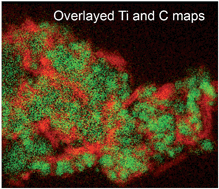Preparation of composite electrodes with carbon nanotubes for lithium-ion batteries by low-energy ball milling
Abstract
Some of the prospective electrode materials for lithium-ion batteries are known to have electronic transport limitations preventing them from being used in the electrodes directly. In many cases, however, these materials may become practical if they are applied in the form of nanocomposites with a carbon component, e.g. via incorporating nanoparticles of the phase of interest into a conducting network of carbon nanotubes. A simple way to prepare oxide–carbon nanotube composites suitable for the electrodes of lithium-ion batteries is presented in this paper. The method is based on low-energy ball milling. An electrochemically active but insulating phase of LiFeTiO4 is used as a test material. It is demonstrated that the LiFeTiO4–carbon nanotube composite is not only capable of having significantly higher capacity (∼105–120 mA h g−1 vs. the capacity of ∼65–70 mA h g−1 for the LiFeTiO4 nanoparticles) at a slow current rate but may also operate at reasonably high current rates.


 Please wait while we load your content...
Please wait while we load your content...